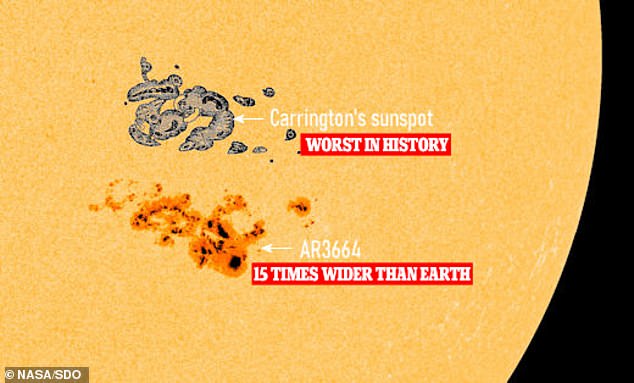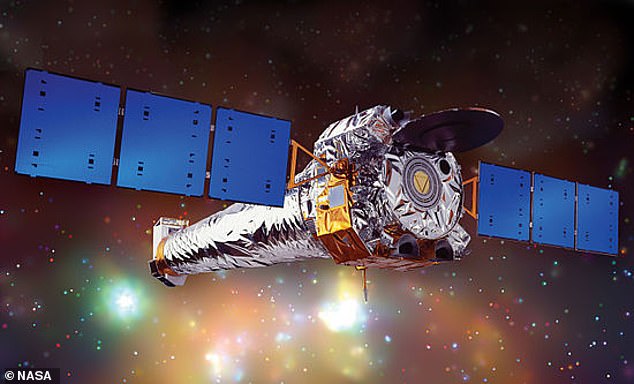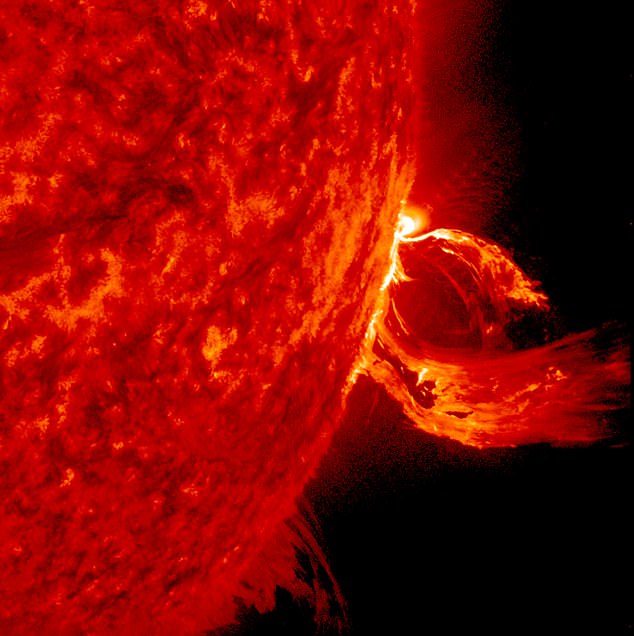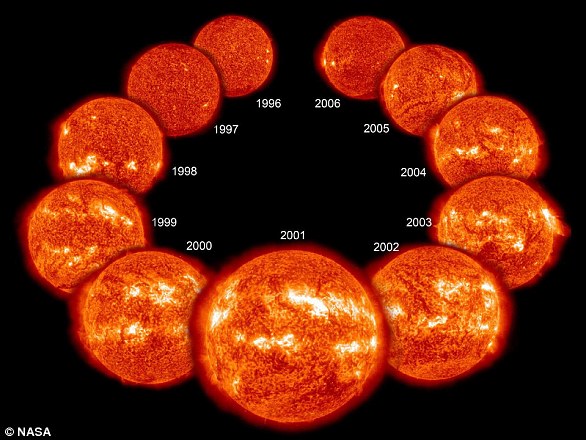While Earth managed to weather last weekend’s strong solar storm, experts have warned that more powerful flares could continue into 2025.
A Harvard astrophysicist told DailyMail.com that the sun has not yet reached its “solar maximum,” the most energetic point in its recurring 11-year solar cycle, in which increased turbulence increases the sun’s total energy output.
That ‘maximum’ will finally arrive in the middle of summer next year: July 2025.
“We could easily have much bigger storms over the next year or two,” Dr Jonathan McDowell told DailyMail.com.
The “extreme geomagnetic conditions (G5)” from last weekend’s solar storm were produced by a disturbance on the sun’s surface, a “sunspot,” that was larger than the solar disturbance that produced the infamous Carrington event of 1859. .
The Carrington solar storm ignited telegraph cables, knocked out communications around the world and even disrupted ships’ compasses, and space weather experts anticipate that a direct hit from the larger solar storms coming soon could be worse.
While Earth managed to weather last weekend’s historic solar storm, experts warn that the risk of more powerful flares will continue to rise through July 2025. “We could easily have much larger storms over the next year or two,” he said. astrophysicist Jonathan McDowell told DailyMail.com.
“It’s definitely a scary time for satellite operators,” Dr. McDowell said.
At the ‘solar minimum’ of 2019, the number of sunspots visible on the sun’s surface was effectively zero, but at the next maximum in July 2025, the US National Space Weather Prediction Center has estimated that there could be up to 115 sunspots.
These magnetically dense areas of turbulence on the solar surface produce more powerful ‘coronal mass ejection’ (CME) solar flares and plasma flares.
While the 11-year solar cycle only increases the total radiation coming out of the sun by a deceptively small 0.1 percent, that excess is highly concentrated in sunspot activity.
These surges of the 173,000 terawatts (trillion watts) of solar energy continually reaching Earth have been documented to disrupt satellites, jam radio communications, and interfere with the power grid.
But even before the busier phase of next year, when Earth could easily find itself in the line of fire of multiple sunspots, there is still a constant strain on the world’s satellite infrastructure right now, simply due to the elevated radiation from the sun. sun as it approaches solar maximum.
“Over the last few months, even without solar storms, the Hubble (Space Telescope) crawl speed has been 10 times greater than during solar minimum,” Dr McDowell told DailyMail.com.
“These solar storms, although dramatic, are really only part of the satellite story,” he explained.
“This entire period of the next few years will attract more satellites than most of the previous decade.”

Sunspot AR3664, which sent out flares last weekend, had reached a size that now rivals the sunspot responsible for the infamous Carrington event of 1895, which set telegraph cables alight, cutting off international communications.
Last Friday’s G5 geomagnetic solar storm disrupted farmers’ ‘global positioning system’ (GPS) satellites and halted planting equipment across the US Midwest.
“All the tractors at the ends of the field are down now because of the solar storm,” said farmer Kevin Kenney. 404 Media Last weekend. “No GPS.”
“I’ve never faced anything like this,” said Patrick O’Connor, who owns a farm about a 90-minute drive south of Minneapolis. told the New York Times.
Some impacts were also felt on the orbital astronomy platforms Dr. McDowell is most familiar with, but he suspects the biggest risks are yet to come.
“This one we had, you know, the aurora was beautiful, it was a big storm, but it certainly wasn’t the biggest storm on record or anything like that,” Dr. McDowell said.
As energetic particles from the solar storm heated Earth’s upper atmosphere this weekend, the heat generated a thickening of the air (similar to how air feels thicker in a sauna), adding “resistance” to the particles. orbital movements of satellites.
Astronomers found that the Hubble Space Telescope is likely to end its life cycle a little earlier, in fact, thanks to the drag created by the solar storm.
Although Hubble is relatively stable in its orbit, its trajectory can be thought of as a long spiral “free fall” that inevitably returns to Earth, and Dr. McDowell said that Hubble’s speed Orbital decay rate doubled “about 80 meters per day instead of 40 meters per day,” due to last weekend’s storm.
“It has multiple impacts,” Dr. McDowell told DailyMail.com.
You have greater resistance. You have greater radiation. You are at increased risk of electrostatic discharge in your spacecraft.’
“Mission controllers are a little more ‘on the edge of their seats’ during a solar storm than on a normal day,” the astrophysicist noted.

Dr. McDowell works with NASA’s Chandra X-ray telescope (above), launched in 1999 to collect X-ray emissions from exploded stars, distant galactic clusters, and the matter swirling in black holes. The Chandra team partially shut down the satellite to weather the solar storm
Dr. McDowell works directly with NASA’s Chandra X-ray Telescope Observatory, launched into distant orbit 86,500 miles away in 1999, to collect X-ray emissions from exploded stars, distant galactic clusters and the matter that swirls in black holes.
“Over the weekend, we took some precautions to save some of his instruments and better protect him from the onslaught of the storm,” he said.
“Turn off certain parts,” Dr. McDowell explained, to reduce the threat of short circuit or electrical damage to Chandra’s sensors, “but not the entire spacecraft.”
“In the past we have lost expensive satellites to solar storms,” he said.
According to a NASA presentation on solar stormsA solar event in 1994 caused electrical failures on three satellites, an Intelsat K communications satellite made by American defense contractor Lockheed Martin and two Canadian Anik television satellites.
While two of the satellites were partially recovered, one was lost without a trace.
“Satellite engineers and scientists are cautious about admitting that the Sun was ultimately to blame when hundreds of millions of dollars are at stake and lawsuits could arise for wrong answers,” NASA’s presentation said.
Right now, the only predictive method space weather experts have to forecast when a large solar storm is likely to occur is to track the path of sunspots.
“If you look at the sunspot orbiting the Sun, what we call an ‘active area,'” Dr. McDowell said, “you can say, ‘Oh, I’m looking at that sunspot and it will be in front of the Earth in two days.’ So if he burps, then we could be in trouble.’
“Therefore, there is a certain level of foresight possible,” he added. “We’re working to improve that.”


